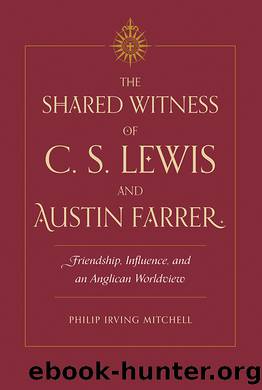The Shared Witness of C. S. Lewis and Austin Farrer by Mitchell Philip Irving;

Author:Mitchell, Philip Irving;
Language: eng
Format: epub
Publisher: The Kent State University Press
FARRER AND THE MIND OF THE EVANGELISTS
Gerhard Ebeling once observed, âWherever historicity is not taken seriously, there is also a failure to take really seriously either the text of the Scriptures or the man to whom this text must be interpretedâ (1967, 28). Ebelingâs point contains a great truth, as well as a great point of debate. The history of twentieth-century biblical criticism, especially its criticism of the Gospels, was a debate about both history and form, and it was a debate that Austin Farrer could not avoid. The nineteenth-century quest for the historical Jesus (and its counterpart in the 1950s) had at its heart the desire to locate a Jesus independent of the biblical witnesses. However, nineteenth-century lives of Jesus, such as that of David Friedrich Strauss or Ernest Renan, tended to produce a human Jesus whose authentic teaching was suspiciously like that of ethical liberalism. As George Tyrell said of Adolf von Harnack, âThe Christ that Harnack sees ⦠is only the reflection of a liberal Protestant face, seen at the bottom of a deep wellâ (1909, 44). It took Albert Schweitzerâs The Quest for the Historical Jesus (1906) to place before the world a more arresting image of Jesus as an apocalyptic eschatologist who expected the end within his lifetime. Schweitzerâs Jesus was perhaps no more miraculous than those of nineteenth-century liberalism, yet for many it put to rest an approach that decontextualized the life of Christ. After Schweitzer, the quest went into decline until the 1950s, and neoorthodox theologians, be they conservatives, such as Karl Barth and Emil Brunner, or more radical, such as Rudolf Bultmann, would downplay, even discount, any attempt to speak âobjectivelyâ of Jesus and his message.
Even given this public retreat, the quest had been about verification and originality, and these concerns did not go away. That these were necessary for sound historical judgment was hardly questioned. The rise of modern critical history continued to stress the testing of sources and independent confirmation: And the parallel search for an objective, critical methodology did not spare the study of Christian scripture. Discrepancies between parallel passages in the Gospels raised questions about their historical accuracy. Determining which gospel was written first, and in addition to oral accounts, whether the gospel writers influenced one another, was important as a means of uncovering the original events. Likewise, a distrust in the miraculous, as well as a sometimes strained standard of credulity, meant that critics would attribute some or much of the gospel materials to legend, myth, or doctrinal interpolation. And the dating of the Gospels was often an important key to determining where they fell in terms of early Christianity. Along with the quest for a Jesus were close examinations of the veracity of the texts. Four approaches in particular were important, and Farrer interacted with them to some degree. These included source criticism, form criticism, redaction criticism, and tradition criticism.
Farrerâs approach to the gospel of Mark, as well as to Matthew and Luke, made him a
Download
This site does not store any files on its server. We only index and link to content provided by other sites. Please contact the content providers to delete copyright contents if any and email us, we'll remove relevant links or contents immediately.
| Ancient & Classical | Arthurian Romance |
| Beat Generation | Feminist |
| Gothic & Romantic | LGBT |
| Medieval | Modern |
| Modernism | Postmodernism |
| Renaissance | Shakespeare |
| Surrealism | Victorian |
4 3 2 1: A Novel by Paul Auster(12260)
The handmaid's tale by Margaret Atwood(7660)
Giovanni's Room by James Baldwin(7160)
Asking the Right Questions: A Guide to Critical Thinking by M. Neil Browne & Stuart M. Keeley(5598)
Big Magic: Creative Living Beyond Fear by Elizabeth Gilbert(5575)
Ego Is the Enemy by Ryan Holiday(5263)
The Body: A Guide for Occupants by Bill Bryson(4943)
On Writing A Memoir of the Craft by Stephen King(4846)
Ken Follett - World without end by Ken Follett(4617)
Adulting by Kelly Williams Brown(4462)
Bluets by Maggie Nelson(4456)
Eat That Frog! by Brian Tracy(4407)
Guilty Pleasures by Laurell K Hamilton(4337)
The Poetry of Pablo Neruda by Pablo Neruda(4016)
Alive: The Story of the Andes Survivors by Piers Paul Read(3953)
White Noise - A Novel by Don DeLillo(3935)
Fingerprints of the Gods by Graham Hancock(3922)
The Book of Joy by Dalai Lama(3879)
The Bookshop by Penelope Fitzgerald(3760)
